Innovating for prevention
Valorizing the environmental sustainability of packaging. This is the ultimate meaning of the Conai Prevention Call*, aimed exclusively at Conai members - be they producers or users - that plan to innovate a packaging solution or its life cycle by altering its environmental impact, saving energy, facilitating recycling, optimizing production and logistics, reducing waste and so on. L.G.
|
CONAI PREVENTION CALL Information on the 2018 edition of the call for projects promoted by the National Packaging Consortium with the support of the Italian Ministry of the Environment will soon be made available at www.conai.org. In the meantime, here are the numbers on the last edition: 146 projects presented, 86 selected from 64 businesses and 7 special prizes, with 400,000 euros awarded to the most innovative and environmentally sustainable packaging solutions put on the market during 2015-2016. It should be kept in mind that submissions are evaluated using Conai’s Eco Tool (www.ecotoolconai.org), which makes it possible to calculate, using a simplified LCA, the impact of preventive actions implemented by businesses on packaging through before-and-after comparisons of water and energy use and CO2 emissions. |
Of the total 400,000 euros in prize money provided by the National Packaging Consortium for the 2017 call for projects, 60,000 euros was awarded to the most virtuous submissions for each packaging material, while 10,000 euros was awarded to those most significant from a technical and design standpoint.
In order to more closely investigate the scope and meaning of the preventive actions taken by concerns in packaging, let us look at those projects deemed worthy of receiving the special prize.
The roads to sustainability are naturally varied and complex. This is illustrated by the responses of operators which we interviewed, which in taking part in our initiative, make clear first and foremost the motivations behind the redesign of their packaging systems and the specific preventive measures they have taken. Also important is the general impact assessment of the choices made in terms of image and competitive positioning. In this issue, the cases of Bonaveri, Basilica Cafaggio, Karton, 4P Mobile Data Processing, Bolton Alimentari, Midiplast and Venegoni.
SUSTENIBILITY: A POINT OF STRENGHT
► BONAVIERI (headquarter a Renazzo di Cento, FE), a producer of artistic mannequins and bust forms, has completely redesigned the packaging of its products with an eye to system simplification and lightening. By redefining volumes, more efficiently organizing components and rationalizing material use, the concern managed to increase the number of primary packaging units that can be loaded onto a standard pallet by 67%. The new packaging system consists in an outer BC heavy triple cardboard box (for impact resistance) and interior die-cut and printed sheets of medium weight BC triple, mostly made from recycled paper (all paper materials are FSC-certified).
The packaging system is completed with expanded polyethylene protective material and bags; the box is closed with gummed paper tape, replacing acrylic adhesive tape.
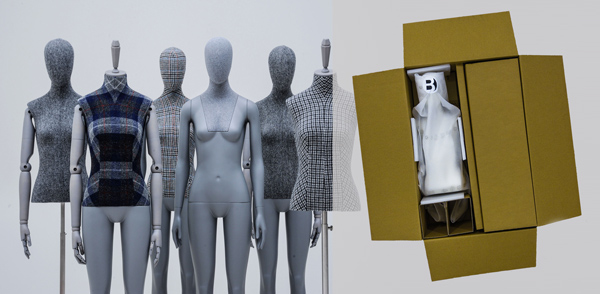
“The Bonaveri project was considered the most significant from a technical and design standpoint. Preventive intervention visiting the entire packaging system enabled the operator to reduce environmental impact throughout the supply chain, through to end of life/new life of the packaging. The simplified lifecycle analysis revealed a reduction in greenhouse gases (-40%), energy consumption (-37%) and water consumption (-56%).
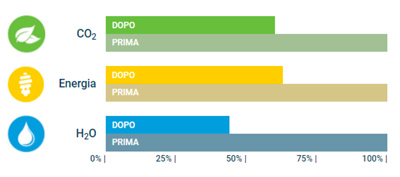
Reasons for the redesign. As Anna Dinelli, Sustainability Manager at Bonaveri, explains: «The company started an environmental footprint reduction process in 2013, beginning with lifecycle analysis of its products, then proceeding to experiments with using bioplastics to produce the mannequins themselves. We only tackled the packaging issue once we had found a material to make our mannequins biodegradable.
In order to assess criticalities and eventually create prototypes of the new packaging model, we turned to the University of Bologna, which worked closely with a four-person team of ours to integrate the functions of acquisitions, research & development, marketing and communication».
Prevention in practice. Dinelli goes on to explain in detail: «Bonaveri followed criteria of improving the product and the process. We redesigned the shape and proportions of the packaging in order to optimize space and reduce bulk. We also eliminated non-recyclable materials, enhanced the arrangement of the parts and valorized the instructions and representation of messages. This sped up packaging operations, with significant advantages for both operator and customer».
Benefits and results obtained. These efforts effectively reduced the environmental impact of the packaging, which can be quantified as a 42% reduction in CO2 emissions, a 38% reduction in energy consumption and a 56% saving on water.
«Beyond measures and statistics - the manager points out - the most meaningful benefits for Bonaveri have to do with communication and image. This project shows the concern’s values and its willingness to innovate all aspects of the production cycle. In fact, the information relating to these results and Bonaveri’s vocation for sustainability are printed on the box as part of a “circular education” process aimed at raising awareness among all actors in the supply chain: producers, suppliers and customers».
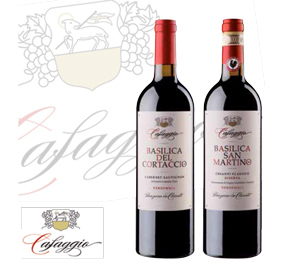 ► BASILICA CAFAGGIO SARL (Greve in Chianti, FI) (Greve in Chianti, FI) is an old Tuscan Winery that produces and bottles quality wines. On the basis of LCAs carried out using Conai’s Ecotool, the redesign of the packaging system of its Chianti Classico Riserva Basilica San Martino and its IGT Basilica del Cortaccio has achieved the best performance in the “glass” category, thanks to an overall saving of raw materials.
► BASILICA CAFAGGIO SARL (Greve in Chianti, FI) (Greve in Chianti, FI) is an old Tuscan Winery that produces and bottles quality wines. On the basis of LCAs carried out using Conai’s Ecotool, the redesign of the packaging system of its Chianti Classico Riserva Basilica San Martino and its IGT Basilica del Cortaccio has achieved the best performance in the “glass” category, thanks to an overall saving of raw materials.
The weight of the 750 ml bottle has in fact been reduced by 27%, the weight of the aluminium capsule by 75% and the weight of the cork by 25%.
“The Simplified LCA type analysis of prevention intervention highlights a reduction of greenhouse gas emissions and use of energy and water resources proportional to the lightening of the bottle of about 33%”.
The reasons for the redesign. As Moreno Nardin, head of the Basilica Cafaggio cellars explained «The general weight reduction of glass and packaging was our primary objective, in accordance with our production philosophy aimed at safeguarding the environment, look out for those natural equilibriums and different ecosystems.
Reducing the weight of packaging certainly means economic savings for the company, but also space saving, and thus also savings on fossil fuels required for handling and moving our products».
Prevention in practice. In designing the new packaging, the company has made a definite choice, favoring weight-reduction and more environmentally friendly solutions for each element of the pack, or that is bottle, cork, carton and capsule.
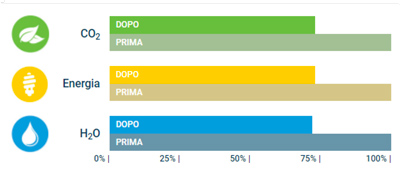
La prevenzione in pratica. Nel progettare il nuovo packaging, la società ha compiuto una scelta precisa, privilegiando - per ogni elemento della confezione, ovvero bottiglia, tappo, cartone, capsula - le soluzioni meno onerose in relazione al peso e più compatibili con l’ambiente.
Benefits and results obtained. As Nardin stresses on this count: «As always, even after a thorough study, it is hard to assess the overall impact of a choice like ours on company business altogether. Certainly we see that even an aspect usually non preponderant in selling a wine – like bottle weight - becomes a matter of debate in markets more sensitive to environmental issues, where it is having a highly positive effect in sharpening our competitive edge.
► KARTON SPA is a family-owned business that for over 40 years has been producing packaging and honeycomb and compact sheets in PP in two plants in Friuli (Sacile and S. Giorgio di Nogaro) destined for the Italian and European markets. Recently it has revised its system for the transport packaging of its visual communication sheets, replacing the wooden pallet with a 12% lighter pallet. In addition, with the same performance, protective plastic components were in turn replaced by lower weight items made up 50% of recycled material. This has enabled us to achieve the best performance in the “wood” category, by streamlining and optimising the system as a whole.
“The preventive intervention has led to a reduction in weight of the pallet and the polypropylene components used for the transport of visual communication sheets. Seen in terms of the packaging lifecycle a net reduction of greenhouse gas emissions and use of energy and water resources has been achieved”.
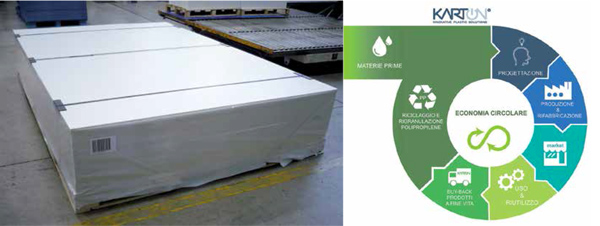
The reasons for the redesign. Jessica Casagrande, Marketing Manager of Karton explains the genesis of the project: “One of our customers, European leader in the distribution of products for visual communication, regularly orders pallets of sheets, which are shipped via truck. We hence redesigned the packaging with a lean view: Speeding up the packaging operations in our logistics department and, at the same time, optimizing our customer’s unpacking operations».
Another reason for satisfaction, Casagrande states, is that the solution is the result of a project shared between «the various sections of Karton, that acted in concert: the improvement input in fact came from our Quality Assurance section supported by our Packaging Design and Logistics team». Moreover, in addition to ensuring customer satisfaction in terms of quality and safety, Karton has long been committed to creating a sustainability-oriented production structure. This is attested by their ISO 9001 Certification System (Quality Management System) as well as Certified Environmental Management System registration in compliance with UNI EN ISO 14001 (and in addition they have also equipped themselves with a polypropylene packaging end-of-life internal recycling system).

Prevention in practice. Casagrande gave a step-by-step explanation of the measures implemented, studying each element of the packaging system concerned, optimizing the use of materials and their weight without sacrificing or compromising the protective capacity of the same. «Aboveall we used a wooden pallet lighter in weight; the two bottom and top sheets protecting the product sheets were initially identical to the product sheets themselves: to avoid waste, we replaced these with lower weight sheets 51.5% comprised of recycled materials drawn from production waste.
The previous packaging entailed that every sharp edge of the product sheets was fully protected by corner profiles (for a total of 11.6 m). In the new version the corner profiles are only positioned where the polypropylene straps are located, the length of which has also been halved (from 34 m to 15 m).
The considerable decrease in the overall weight of the packaged product - the manager adds - has led to a threefold advantage, comprising the reduction of raw materials for the production of the packaging itself, reduction of energy resources used as well as a reduction of greenhouse gas emissions both in packaging production as well as in overall transportation».
Benefits and results obtained. The complete rethink of the packaging for their visual communication product sheets, as implemented by Karton, in the first instance guarantees «an immediate and tangible advantage to the customer that, presented with a perfectly packaged product, receives less material that needs to be sent to landfills, with a consequent reduction in disposal costs. On top of that - Casagrande concludes - we cannot underestimate the reduction of CO2 emissions related to transportation of goods to foreign countries, precisely because of the lower volumes and weight thanks to a simplified and optimized packaging».
► 4P MOBILE DATA PROCESSING SRL (headquarters in Padua) produces handheld PCs for professional applications and markets them across the globe.
In 2015, the firm updated the packaging system of its FDA600 field digital assistant to make it more environmentally sustainable.
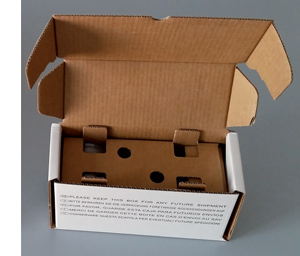 Originally consisting in a paper component and a plastic one, it now employs just one material, making it more easily recyclable, and the exterior component now contains a higher proportion of recycled material. Furthermore, the redesign has reduced the weight and volume of the packaging, optimizing logistics operations by increasing the number of primary packaging units that can be transported on standard pallets by 149%. 4P received the special prize in the category “paper”.
Originally consisting in a paper component and a plastic one, it now employs just one material, making it more easily recyclable, and the exterior component now contains a higher proportion of recycled material. Furthermore, the redesign has reduced the weight and volume of the packaging, optimizing logistics operations by increasing the number of primary packaging units that can be transported on standard pallets by 149%. 4P received the special prize in the category “paper”.
“Simplified life cycle analysis of the project evidences a greenhouse gas emission reduction of 65%, a 55% reduction in energy consumption and a 29% reduction in water consumption, especially thanks to the increased proportion of recycled material and a packaging that is easier to recycle”.
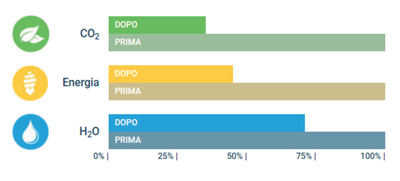
Reasons for the redesign. What motivated the redesign of a pacakging system in accordance with the principles of prevention?
Silvano Mansutti, General Manager of 4P Mobile Data Processing, doesn’t mince words on the matter. «In addition to reusability (4P customers must be able to send back to the company any devices that require assistance or updates, Editor’s note), we cared about reducing packaging bulk by using easily recyclable materials. At the same time, we aimed to create a rugged packaging solution, that can be reused multiple times. We basically followed two guiding criteria: firstly, the economic dimension, reducing storage and shipping costs; secondly, we had the environment in mind, looking to use just one material, one that was recyclable... and cardboard proved the right answer».

Prevention in practice. With less bulk than the previous version (-52% volume, -24% weight), the new packaging of 4P products thus achieves excellent results in terms of saving on raw materials.
«By replacing the interior protective layer of polyethylene with corrugated cardboard - explains Mansutti - we managed to further simplify the entire packaging system, with a significant impact on logistics operations, first, and later on transport. We have calculated a -79% reduction in unassembled material bulk in the warehouse, while the significant reduction in assembled packaging bulk has enabled us to optimize shipping by enhancing the number of products that can be loaded onto a pallet».
Benefits and results obtained. Regardless of the economic benefits of these choices, according to the manager «4P is really cashing in on investments in image and competitive positioning: the new packaging, or rather the new “attire” with which we present our high end handheld PC for business applications, has had a strong impact on our business, in part because our customers immediately perceived us as best in class, and the CONAI award serves as the ideal platform for that message».
► BOLTON ALIMENTARI SPA, which has always been conscientious about its environmental impact, has worked hard over the years to enhance the performance of its packaging solutions. In particular, in 2015, the firm reduced the thickness of the can and easy-open aluminium cover of its Rio Mare salmon filet, saving 10% on the raw material used to package 150 g of product.
The solution earned it the special prize in the category “aluminium”.
“Simplified life cycle analysis shows a reduction in greenhouse gas emissions and energy and water use proportional to the lightening of the aluminium can and cover”.
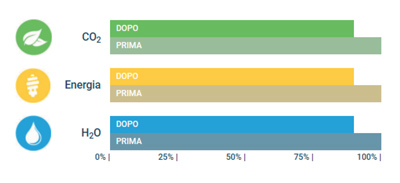
Reasons for the redesign. Come spiega Luciano Pirovano, CSR Director di Bolton Alimentari «Il nostro “viaggio” verso la sostenibilità, i cui temi sono ormai parte integrante del business aziendale, ha portato Bolton Alimentari a dare vita, nel 2011, alla “Qualità Responsabile”.
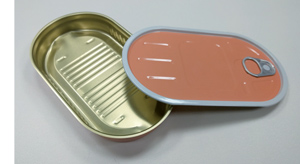 Si tratta di un progetto strategico di lungo periodo di Corporate Social Responsibility, che rappresenta l’impegno per una qualità a tutto campo, perseguita responsabilmente lungo l’intera filiera per garantire la sostenibilità ambientale, economica e sociale.
Si tratta di un progetto strategico di lungo periodo di Corporate Social Responsibility, che rappresenta l’impegno per una qualità a tutto campo, perseguita responsabilmente lungo l’intera filiera per garantire la sostenibilità ambientale, economica e sociale.
Il progetto si sviluppa lungo quattro linee d’azione fondamentali: la pesca sostenibile e la tutela dell’ecosistema marino, il rispetto per l’ambiente, il rispetto per le persone e la corretta nutrizione.
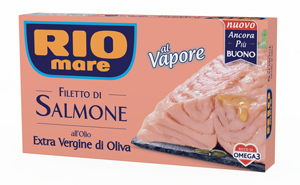 In particolare, l’azienda presta molta attenzione al proprio impatto sull’ambiente, con l’obiettivo di offrire un contributo concreto allo sviluppo di un futuro sempre più sostenibile. Per questo controlla le prestazioni ambientali dei propri stabilimenti e sensibilizza i fornitori sui temi dell’efficienza, del risparmio dei consumi energetici, di quelli idrici e, se necessario, li accompagna verso l’utilizzo ottimale delle materie prime. Per quanto riguarda poi nello specifico gli imballaggi - precisa Pirovano - negli anni, e di concerto con i fornitori, l’azienda ha svolto un intenso lavoro per migliorare le performance delle confezioni. L’impegno si è concentrato sulla riduzione degli spessori dei materiali di imballaggio, generando così un deciso beneficio ambientale e ottenendo un notevole risparmio sull’utilizzo di materie prime».
In particolare, l’azienda presta molta attenzione al proprio impatto sull’ambiente, con l’obiettivo di offrire un contributo concreto allo sviluppo di un futuro sempre più sostenibile. Per questo controlla le prestazioni ambientali dei propri stabilimenti e sensibilizza i fornitori sui temi dell’efficienza, del risparmio dei consumi energetici, di quelli idrici e, se necessario, li accompagna verso l’utilizzo ottimale delle materie prime. Per quanto riguarda poi nello specifico gli imballaggi - precisa Pirovano - negli anni, e di concerto con i fornitori, l’azienda ha svolto un intenso lavoro per migliorare le performance delle confezioni. L’impegno si è concentrato sulla riduzione degli spessori dei materiali di imballaggio, generando così un deciso beneficio ambientale e ottenendo un notevole risparmio sull’utilizzo di materie prime».
Prevention in practice. L’azienda ha dunque messo in campo numerose azioni per ridurre gli spessori di molti suoi packaging, ottenendo un risparmio annuo di 44 tonnellate di banda stagnata «… pari al peso di circa 40 utilitarie! Ricordo, al riguardo, che negli ultimi anni abbiamo partecipato e vinto tre volte il bando CONAI per la prevenzione, con progetti volti a ridurre gli spessori delle lattine e dei coperchi in banda stagnata e alluminio del Tonno Rio Mare all’olio di Oliva da 120 g e del Filetto di Salmone Rio Mare».
Benefits and results obtained. «The overall impact of these initiatives is clearly positive - the manager continues - in that the reduced thickness of the packaging materials, in addition to carrying environmental benefits, also guarantees an economic saving tied to the annual saving on tonnes of packaging. Furthermore, for a concern like ours, winning the prestigious CONAI prevention contest for a third consecutive year represents a major benchmark. It is a recognition of the actions that we have been implementing in the name of sustainability. All the projects we have carried out in packaging, along with those we have long been developing in the field of sustainable fishing, with the people that work with us along the supply chain and in proper nutrition are demonstrating to consumers and stakeholders the central importance of sustainability to Bolton Alimentari».
► MIDIPLAST SRL produces plastic packaging for various sectors. It has completely redesigned the packaging system of its 500 ml HDPE flacon in order to reduce the environmental impact of its processes.
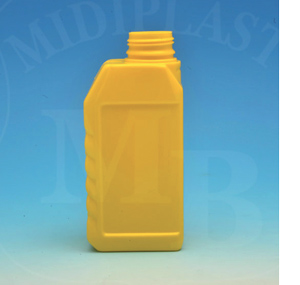 The process of producing the flacon has been optimized by replacing single stamp with triple stamp, enabling a 67% saving on electricity use. The packaging system was revisited to save on raw materials - cardboard and LDPE film - as well as increasing the number of primary packaging units per pallet (+26%). Furthermore, the cardboard trays and pallets, originally one-time use, are now reused after each delivery. Midiplast won the special prize in the category “plastic”.
The process of producing the flacon has been optimized by replacing single stamp with triple stamp, enabling a 67% saving on electricity use. The packaging system was revisited to save on raw materials - cardboard and LDPE film - as well as increasing the number of primary packaging units per pallet (+26%). Furthermore, the cardboard trays and pallets, originally one-time use, are now reused after each delivery. Midiplast won the special prize in the category “plastic”.
“The modification of the stamping used to create the 500 ml flacon enabled increasing hourly production and reducing energy consumption tied to packaging production. Logistics have also been improved by increasing the number of packaging units transported on a pallet. The prevention action has enabled reducing greenhouse gas emissions as well as energy and water resource consumption”.
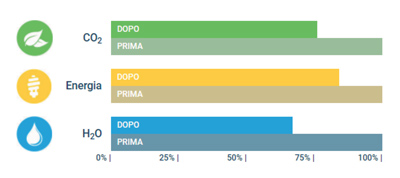
Reasons for the redesign. «To create a packaging able to better preserve the contents while at the same time also protecting the environment outside of it». With this firm conviction that the packaging is an important part of prevention, sustainability and innovation, Cesare Baroni, managing partner of Midiplast, introduces the renewal which his company has undergone in terms of production and strategy. «Based on our needs and capacities, we worked to make Midiplast greener by redesigning our activities on the basis of a environmentally sustainable strategy, promoting more responsible behaviors among our employees and, most importantly, paying closer attention to waste of energy, water and raw materials».

The company has adopted many concrete measures in this direction, such as replacing old, “power-guzzler” machinery with modern, high performance and energy efficient ones (such is the case of oleodynamic blowers replacing electric ones, leading to an energy consumption reduction equal only to the increased output and a reduction in used oil disposal). The more advanced equipment made it possible to transition from single stamp to triple, increasing the productivity of the blowers. Finally, the installation of solar panels enables meeting energy needs from a renewable source.
Prevention in practice The design and production of a more sustainable packaging followed a careful analysis of energy consumption. Baroni explains: «In addition to the steps strictly to do with production, we also sought to reduce our environmental impact by using the packaging system in a smarter way, changing the orientation of the flacons and making the secondary packaging more capacious.
In order to optimize storage and space management, we reduced the use of pallets and used cardboard boxes and trays that, in addition to being less bulky, make it possible to better organize a high number of flacons/bottles. We also intervened in the last phase, i.e. shipping, which is now organized “when ready” so that the truck can be completely loaded, or by combining deliveries to customers/suppliers that are located close to one another. This strategy enables us to limit the number of trips that our drivers have to make, thereby reducing emissions. Finally, we ask our customers to return unused secondary packaging, so that they can be reinserted into the supply chain».
Benefits and results obtained. «In the last analysis, a sustainable prevention action - the manager reflects - not only benefits the environment, but also the company image, as well as consumers, since the reduced production costs positively affect the final price of a product. As the marketing tool par excellence, the fact that a packaging is made more conscientiously, adopting saving strategies and reusing raw materials, nowadays that enhances visibility, guaranteeing a competitive edge in market positioning».
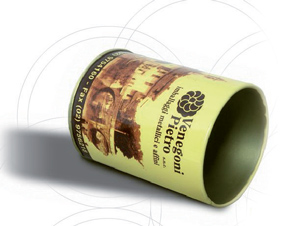 ► VENEGONI SRL has been making metal packaging since 1973.
► VENEGONI SRL has been making metal packaging since 1973.
The concern has redesigned its 250 ml can to enhance its environmental performance. The diameter and height have been reduced, resulting in a 9% weight reduction and a 15% optimization of logistics.
The intervention has earned the firm the special prize in the category “steel”.
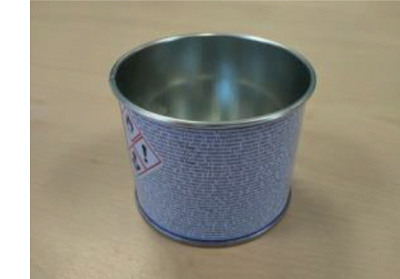
“The can’s screw-cap has been replaced with one that snaps on. The weight has been reduced by 19%, and the number of pieces per pallet has been increased by 16%. These interventions have led to a reduction in greenhouse gas emissions, while energy and water consumption have been reduced in proportion to the lightening of the packaging”.

















